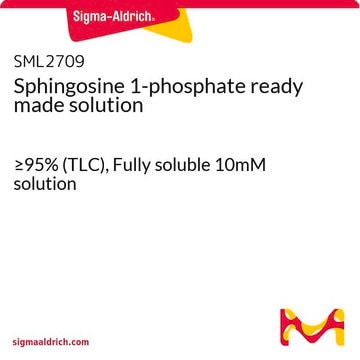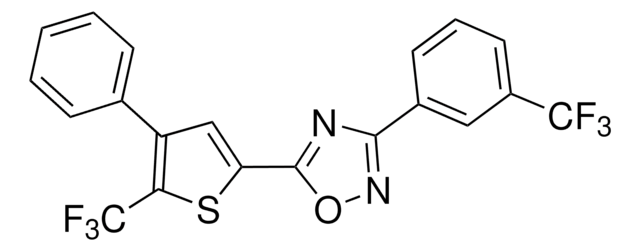Another supplier (APExBIO) suggests using a solvent of 0.3M NaOH for in vitro work, as the substance is soluble in it at less than 4 mg/mL. They also recommend warming the tube at 37°C and shaking it in an ultrasonic bath for a while to achieve higher solubility. The stock solution can be stored below -20°C for several months.
S9666
Sphingosine 1-phosphate
≥95% (TLC), powder, lipid second messenger
Synonym(s):
(2S,3R,4E)-2-Amino-4-octadecene-1,3-diol 1-phosphate, D-erythro-Sphingosine 1-phosphate
Select a Size
Select a Size
About This Item
Recommended Products
Product Name
Sphingosine 1-phosphate, ≥95%, powder
Quality Level
Assay
≥95%
form
powder
storage temp.
−20°C
SMILES string
CCCCCCCCCCCCC\C=C\[C@@H](O)[C@@H](N)COP(O)(O)=O
InChI
1S/C18H38NO5P/c1-2-3-4-5-6-7-8-9-10-11-12-13-14-15-18(20)17(19)16-24-25(21,22)23/h14-15,17-18,20H,2-13,16,19H2,1H3,(H2,21,22,23)/b15-14+/t17-,18+/m0/s1
InChI key
DUYSYHSSBDVJSM-KRWOKUGFSA-N
Gene Information
human ... S1PR1(1901) , S1PR2(9294) , S1PR3(1903) , S1PR4(8698) , S1PR5(53637)
Looking for similar products? Visit Product Comparison Guide
Related Categories
Biochem/physiol Actions
Features and Benefits
Storage Class Code
11 - Combustible Solids
WGK
WGK 3
Flash Point(F)
Not applicable
Flash Point(C)
Not applicable
Personal Protective Equipment
Choose from one of the most recent versions:
Certificates of Analysis (COA)
Don't see the Right Version?
If you require a particular version, you can look up a specific certificate by the Lot or Batch number.
Already Own This Product?
Find documentation for the products that you have recently purchased in the Document Library.
Customers Also Viewed
Articles
Discover Bioactive Small Molecules for Lipid Signaling Research
-
Will using methanol as a solvent to dissolve the powder affect or disrupt the huvect cell line?
1 answer-
Helpful?
-
Active Filters
Our team of scientists has experience in all areas of research including Life Science, Material Science, Chemical Synthesis, Chromatography, Analytical and many others.
Contact Technical Service













